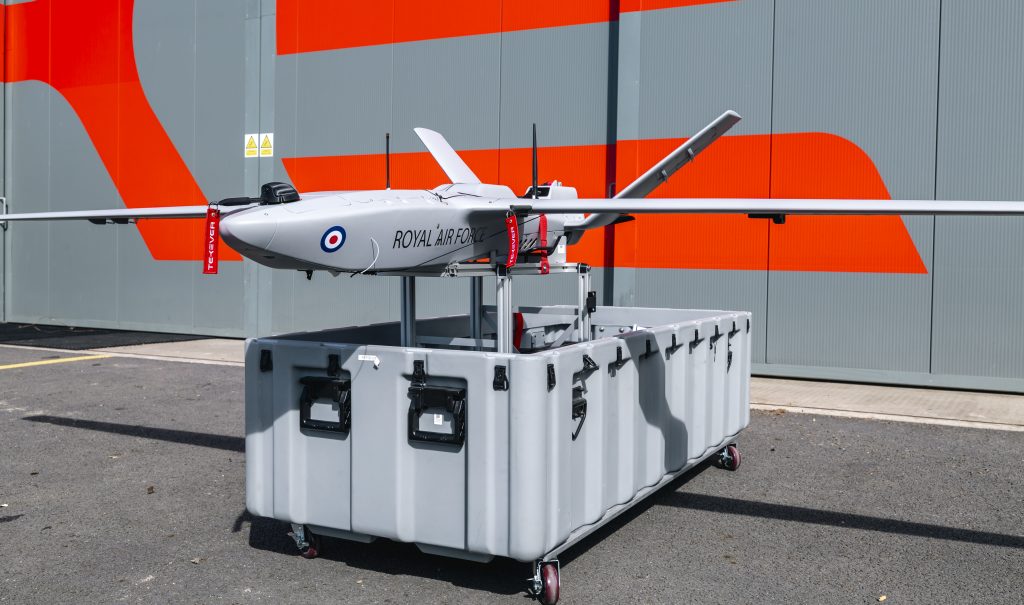RAF inducts StormShroud to jam enemy radars
The Royal Air Force (RAF) has taken StormShroud, a new uncrewed aircraft into service to act as an autonomous collaborative platform to its F-35B and Typhoon fleets, supporting the suppression of enemy air defence role, according to a 2nd May article released by the RAF.
StormShroud is the first of a family of autonomous collaborative platforms, the announcement states, indicating that further variants will follow supporting the RAF in different missions. It has been developed by a teaming of the UK’s Defence Science and Technology Laboratories (DSTL), the RAF’s Rapid Capabilities Office and with companies Tekever and Leonardo, providing the airframe and electronic warfare payload respectively.
“Lessons learned from the war in Ukraine have boosted StormShroud’s production and it’s taken just a year from the Urgent Capability Requirement (UCR) being endorsed to deliver the new capability, significantly reducing programme time and costs,” the announcement adds. The project is described as “one of the first RAF high-risk capabilities; where cutting edge technology is brought into service with a balanced and risk-aware approach to assurance, avoiding excessive time and cost penalties.” This indicates that the systems in use on StormShroud have been brought into service with some level of programmatic risk accepted.
Often UK programmes will be required to work through all development of a platform before it enters service, extensively de-risking it to ensure it meets user requirements. It is likely that StormShroud will see some further spiral development now that it is in service to bring it fully inline with the RAF’s needs.
There are a few things at play here that are worth discussing; collaborative combat aircraft and jamming modalities. The uncrewed collaborative combat aircraft element essentially indicates that the StormShroud will coordinate with crewed aircraft, likely pushing ahead of them to find enemy radars and air defence networks and spoof them, presumably without being shot down itself. The use of BriteCloud from Leonardo is key to this, as it provides “ghost signals” designed to spoof the radar into providing false returns rather than jamming it.
Jamming a radar relies more on brute force than anything else. It needs the jamming radar to have more power output than the jammed radar, the closer the jamming radar gets to the target, the more power it needs to successfully jam. This is because the emitting power of the target radar can overpower the jamming radar. This is a bit of a simplification, there is a lot that goes into jamming including moving through frequencies etc. but broadly speaking, this approach requires a lot of power, which has historically required a bigger platform like the EA-18G Growler, a fixed wing jet, to achieve. The RAF’s solution is much smaller and hopefully far more cost-effective than an $80 million F-35B and pilot.
StormShroud will be deployed and operated by the RAF’s 216 Squadron, which was reformed in 2020 and tasked specifically with testing and experimenting with new uncrewed capabilities. It will work with Royal Auxiliary Air Force personnel as well as the RAF regiment to deploy into hostile areas and liaise with Typhoon and F-35 squadrons, the announcement explains. It appears that StormShroud will deploy from one location and either meet with the RAF’s crewed aircraft en route to a strike mission, or it may even deploy separately from them, conducting its mission independently.
“Autonomous collaborative platforms will revolutionise how we conduct a range of missions, from intelligence gathering to strike and logistical support. We are excited to be at the forefront of this innovation and are working closely with industry partners to explore the possibilities,” said Air Chief Marshal Sir Rich Knighton, Chief of the Air Staff, hinting at the other roles that collaborative combat aircraft might play. Other forces and defence companies are working on the use of collaborative combat aircraft to support air superiority with air-to-air combat, a recent announcement from Lockheed Martin’s Skunk Works focused on this, for example.
Tech profile: StormShroud
The video above is from Tekever, it shows the AR3 in operational use over Ukraine, providing reconnaissance for artillery units. Credit: Tekever.
StormShroud is based on the AR3 platform from Tekever and the BriteCloud electronic warfare payload from Leonardo, both are manufactured in the UK. Starting with the AR3, it is an operationally proven uncrewed aerial system with over 10,000 hours on deployment in Ukraine, where it operates at distances of 200 km to 300 km from the frontline, according to Tekever. The platform’s use in that war has led to more than 100 iterative upgrades, the company adds.
It is a fixed wing platform that is catapult launched and can be converted to vertical take off and launch through the addition of rotary wing motors to the wings. It has a maximum take-off weight of 25 kg including 4 kg of payload and an endurance of 16 hours in the standard fixed-wing configuration. The operational range is stated to be 100 km by Tekever, indicating that Ukrainian units may be using signal repeaters to operate their AR3s at greater range. It has a cruise speed from 75 to 90 km/h, a 3.5 m wingspan and length of 1.9 m. It appears to be powered by a conventional propeller, which supports the assessment that it will operate in collaboration with, but independently of, fixed wing jets. As it can carry an array of payloads, the AR3 or Tekever’s other UAVs may suit the British Army’s recently announced Project Corvus, which aims to provide long-range target acquisition for the Royal Artillery.
The Leonard BriteCloud is a well-known system that uses digital radio frequency memory (DRFM) to spoof and suppress enemy radars. BriteCloud essentially mimics radar frequencies. The DRFM technology receives radar signals and then generates a return signal based on the radar’s design that paints a false picture of what is happening. This might, for example, indicate that there are no aircraft present, or that they are in a different place at a different speed and so on. All of this would ideally happen without the air defence crew becoming aware that they are being spoofed. In comparison, conventional jamming, which may very quickly alert a crew to the presence of enemy aircraft.
Company profile: Tekever

StormShroud is based on the AR3 platform from Tekever, which has flown 10,000 hours (416 days) worth of combat missions over Ukraine in support of long-range targeting. Credit: RAF.
Tekever has its HQ in Lisbon, Portugal, and a production facility in Wales. It provides surveillance as a service in the maritime domain as well as digital capabilities and space-based solutions. It has a family of UAVs including the AR3 and the much larger AR5 with a 50 kg payload. Founded in 2001 by students of Portugal’s Instituto Superior Técnico, the school of engineering and technology at the University of Lisbon, the company has secured orders for its UAVs from nine international customers as well as the UK. Within the UAV supply chain, the company provides core components as well as software and AI-enabled capabilities.
In 2023, the Tekever Group had a turnover of £18 million ($22.41 million/€21.01 million) and an operating profit of £2.6 million ($3.24 million/€3.03 million), which represented a growth rate of 1.73% year-on-year at the time. Tekever raised series B funding in November 2024, the funding round was led by Baillie Gifford and included participation from the NATO Innovation Fund, the U.K.’s National Security Strategic Investment Fund, and Crescent Cove Advisors LP. Baillie Gifford has backed AirBnB, SpaceX, and Spotify. The funding round secured €70 million ($73.34 million/£58.02 million), this followed from the Series A funding, announced in January 2022 and valued at €20 million ($22.74 million/£16.68 million). That round was led by Ventura Capital, “a global growth fund specializing in pre-IPO technology leaders, and joined by financial investors including Iberis Capital, and strategic investors including leading Maritime Industry and Shipping OEMs. The Growth Stage acted as Placement Agent for this funding round,” Tekever said at the time.
Shortly after the RAF’s announcement, Tekever also met with the UK’s Prime Minister, Keir Starmer, to announce a £400 million ($500 million/€468 million) investment in the UK, which will support 1,000 jobs, the company states. The investment is part of Tekever’s five-year UK development program, which it refers to as OVERMATCH. It is designed to “transform the nation’s defence capabilities by accelerating innovation in AI and autonomy,” the company states. It will join others like Arondite, Helsing, Kraken, and Anduril UK, which are all developing domestic AI capabilities for the UK’s armed forces.
Calibre comment
The suppression of enemy air defence (SEAD) mission is a critical one for the RAF. It is a role that NATO has relied upon the US Air Force to perform for some time, allowing SEAD-dedicated assets like the Tornado GR 4, with IX (B) to atrophy and pass from service. However, NATO forces are now trying to regenerate the capability to counter Russia’s layered air defence networks, which are specifically designed to degrade and reduce the efficacy of NATO air strikes and air power. Jamming and suppressing enemy radars is key for this role as it enables strike packages of aircraft to fly into enemy airspace, striking critical targets like ammunition factories and command nodes, or destroying air defence systems. The other element, which the UK has not yet fully addressed, is a missile that can be deployed at long ranges to destroy air defence systems. The UK has a nascent capability in the SPEAR family of cruise missiles developed by MBDA, but the missiles are yet to enter service. StormShroud combined with SPEAR and the F-35 fleet will make the UK a fairly capable SEAD air force.
By Sam Cranny-Evans, published on 3rd May, 2025.

Sign Up for Updates!
Get insider news, tips, and updates. No spam, just the good stuff!






